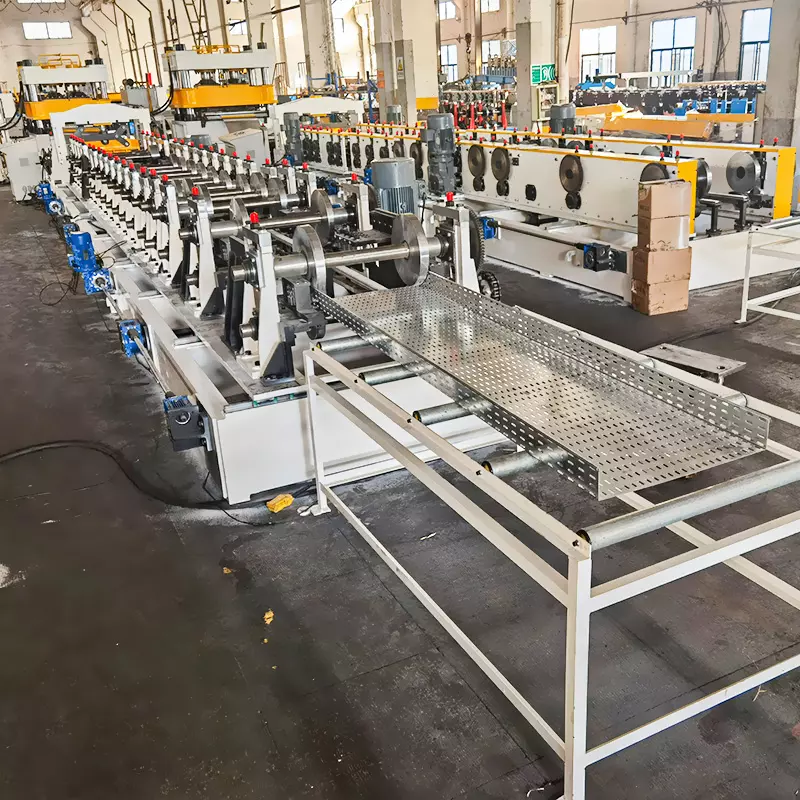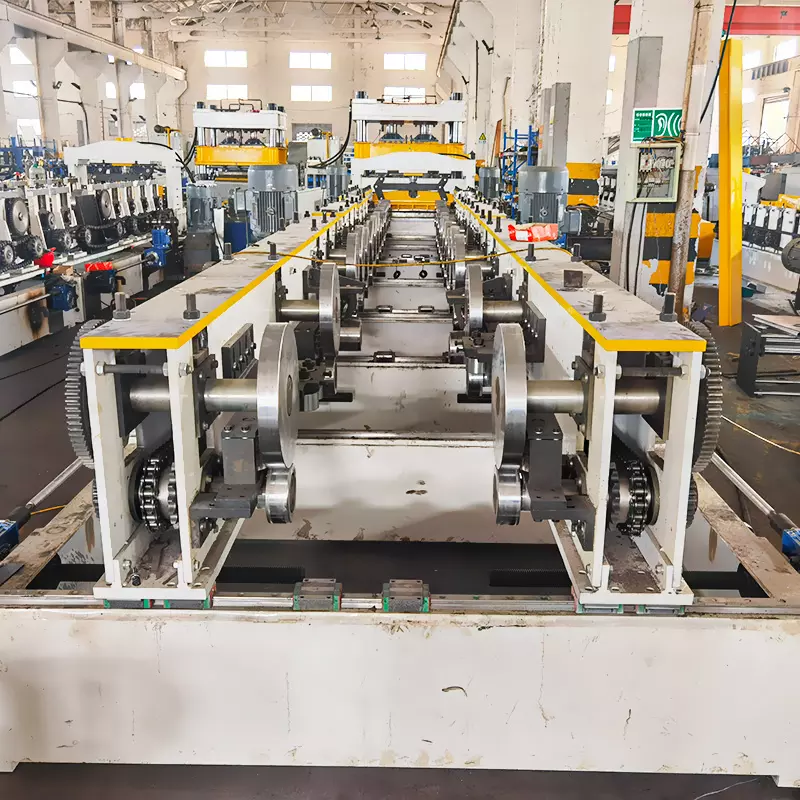مقدمة
عندما يتعلق الأمر ب metal forming, two of the most commonly used techniques are التشكيل بالدلفنة والكبح بالكبس. Both processes shape metal sheets into precise profiles, but they differ in speed, efficiency, cost, and suitability for different applications.
So, which one should you choose?
In this guide, we’ll compare roll forming vs. press braking في 2025, covering:
✅ How each process works
✅ Key differences in speed, cost, precision, and efficiency
✅ Best applications for each method
✅ Which industries rely on roll forming vs. press braking?
✅ Why roll forming is the preferred choice for high-volume production
هيا بنا نتعمق!
فهم التشكيل بالدرفلة
ما هو تشكيل اللفة؟
Roll forming is a continuous metal forming process that shapes sheet metal into long, uniform profiles باستخدام a series of roller stations. The material passes through multiple rollers that gradually shape it into the desired cross-section.
كيف يعمل التشكيل بالدرفلة
| الخطوة | Process Description |
|---|---|
| 1. تحميل الملف | A metal coil is fed into the roll forming machine. |
| 2. Progressive Forming | The sheet passes through a series of rollers that gradually bend the metal into shape. |
| 3. Inline Cutting & Punching | الملف الشخصي هو cut to length و punched if necessary. |
| 4. Final Inspection & Packaging | الملامح النهائية هي فحص الجودة وإعدادها للشحن. |
نصيحة محترف: Roll forming is best for high-volume, continuous production من uniform metal profiles.
Understanding Press Braking
What is Press Braking?
Press braking is a metal bending process that uses a هيدروليكي or mechanical press brake to bend metal sheets into specific angles. The metal is placed between a punch and die, which exert force to form the sheet into the desired shape.
How Press Braking Works
| الخطوة | Process Description |
|---|---|
| 1. Sheet Placement | A flat metal sheet is positioned on the press brake. |
| 2. Die & Punch Selection | The appropriate die and punch combination is chosen for the required bend. |
| 3. Bending Process | The press brake applies force, bending the sheet into the desired angle. |
| 4. Inspection & Adjustment | The formed part is checked for accuracy and adjusted if necessary. |
نصيحة محترف: Press braking is best for low-volume production و custom one-off bends.

Roll Forming vs. Press Braking: Key Differences
| الميزة | تشكيل لفة | الضغط على المكابح |
|---|---|---|
| سرعة الإنتاج | Continuous, high-speed production (up to 50m/min) | Slower, batch-based production |
| الأفضل لـ | الإنتاج بكميات كبيرة من uniform profiles | Low-volume, custom bends |
| تكلفة الأدوات | Higher initial tooling cost but lower per-unit cost | Lower tooling cost but higher per-unit cost |
| المرونة | Limited to pre-designed profiles | Highly flexible for custom bends |
| Precision & Tolerance | Highly precise, minimal distortion in long profiles | Good for shorter sections, but less accurate for long profiles |
| النفايات المادية | Minimal waste due to continuous process | More waste due to trial-and-error adjustments |
| الأتمتة | Fully automated with inline cutting, punching, and welding | Requires تعديلات يدوية |
| Labor Intensity | Low labor requirement | High labor requirement |
الحكم:
- Roll forming is better for large-scale industrial production حيث speed, consistency, and cost-efficiency matter.
- Press braking is better for custom, small-batch, or prototype production حيث flexibility is required.
When to Use Roll Forming vs. Press Braking
Roll Forming is Best For:
✅ الإنتاج بكميات كبيرة (e.g., automotive, construction, solar industries)
✅ Long, uniform profiles (e.g., C & Z purlins, metal roofing, highway guardrails)
✅ Reducing material waste and labor costs
✅ Achieving high precision with minimal distortion
Press Braking is Best For:
✅ Low-volume, custom jobs (e.g., small fabrication shops, prototyping)
✅ Short-length metal components that require angular bends
✅ Quick setup with minimal tooling costs
If you need high-speed, cost-efficient production, go with roll forming. If you need flexibility for low-volume jobs, press braking is the better choice.
Industries That Use Roll Forming vs. Press Braking
| الصناعة | تشكيل لفة | الضغط على المكابح |
|---|---|---|
| السيارات | Structural components, crash-resistant beams | Custom brackets, low-volume parts |
| الإنشاءات | Metal roofing, wall panels, purlins | Custom trim, window frames |
| أرفف ورفوف | Warehouse storage racks, uprights, beams | Custom shelf brackets |
| الطاقة الشمسية | PV mounting structures, solar panel frames | Small mounting brackets |
| الفضاء الجوي | High-strength structural components | Custom one-off parts |
نصيحة محترف: Roll forming is widely used in industries requiring mass production, while press braking serves more niche, low-volume applications.
Why Roll Forming is the Future of Metal Forming
As industries move towards automation, efficiency, and cost reduction, roll forming is becoming the preferred choice for large-scale manufacturers.
Advantages of Roll Forming Over Press Braking
✅ 50% faster production speeds
✅ 70% lower labor costs due to automation
✅ الحد الأدنى من نفايات المواد
✅ Inline processing reduces post-production work
✅ Perfect for industries with high-volume needs
Looking for a high-speed, precision roll forming machine? ماكينة صنواي العروض أحدث حلول التشكيل بالدرفلة لـ global manufacturers.
Common Problems & Solutions in Roll Forming vs. Press Braking
حتى مع advanced roll forming and press braking technologies, manufacturers may encounter challenges such as material deformation, misalignment, and production inefficiencies. معالجة هذه المشكلات في وقت مبكر يضمن consistent quality, reduced downtime, and improved efficiency.
Troubleshooting Guide for Roll Forming vs. Press Braking
| الإصدار | Roll Forming Cause & Solution | Press Braking Cause & Solution |
|---|---|---|
| تشويه الملف الشخصي | Misaligned rollers, incorrect pressure settings → Recalibrate rollers and adjust forming pressure | Incorrect punch and die selection → Use properly matched punch and die |
| Material Wrinkling | Uneven material feeding → Ensure uniform material tension and adjust guide rolls | Over-bending of the sheet → Reduce bending force or adjust die clearance |
| أبعاد غير متناسقة | Roller wear or incorrect CNC settings → Inspect rollers and recalibrate CNC programs | Manual setup errors → Use automated press brakes for higher accuracy |
| خدوش السطح | Dirty rollers or improper lubrication → Clean rollers and apply anti-scratch coatings | Poor-quality punch/die or excessive force → Use high-precision tools and adjust force settings |
| Slow Production Speed | Overloaded machine or incorrect material thickness → Optimize material input and machine settings | Manual bending sequence errors → Use CNC-controlled press brakes |
نصيحة محترف: عادي machine calibration and preventive maintenance يمكن reduce errors by up to 60% و increase production efficiency significantly.
Future Trends in Roll Forming & Press Braking (2025 & Beyond)
ال metal forming industry is evolving rapidly, with automation, AI, and sustainability تشكيل مستقبل roll forming and press braking technologies.
Key Innovations for 2025
1. AI-Powered Quality Monitoring
- مدفوعة بالذكاء الاصطناعي real-time defect detection improves quality control.
- Reduces material waste and ensures consistent accuracy.
2. المصانع الذكية المزودة بإنترنت الأشياء
- Machines are now integrated with المراقبة المستندة إلى السحابةتمكين التشخيص عن بُعد والصيانة التنبؤية.
- التحسينات تتبع الإنتاج والكفاءة التشغيلية.
3. Servo-Driven Press Brakes & Roll Forming Machines
- يحسن التحكم في السرعة، والدقة، وكفاءة الطاقة.
- يقلل البلى على المكونات الميكانيكيةزيادة العمر الافتراضي للماكينة.
4. تعديلات الملف الشخصي المؤتمتة بالكامل
- يزيل تعديلات يدوية عند التبديل بين ملفات تعريف مختلفة.
- التحكم باستخدام الحاسب الآلي الرقمي التبديل التلقائي للملف الشخصي تقليل وقت التعطل وتحسين الكفاءة.
Upgrading to AI-powered roll forming and press braking technologies can increase production efficiency by up to 50%!

Automation in Roll Forming vs. Press Braking
الأتمتة هي إحداث ثورة roll forming and press braking, making them أذكى وأسرع وأكثر فعالية من حيث التكلفة.
Comparison of Automation Features in Roll Forming & Press Braking
| Automation Feature | تشكيل لفة | الضغط على المكابح |
|---|---|---|
| CNC & PLC Control | Ensures precise profile formation with minimal waste | Fully automated bending sequences for accuracy |
| الكشف عن العيوب المستند إلى الذكاء الاصطناعي | Identifies defects in real-time, reducing material waste | Detects bending errors and corrects force distribution |
| إنترنت الأشياء والمراقبة عن بُعد | Allows manufacturers to track machine performance remotely | Enables predictive maintenance and operational tracking |
| التبديل الآلي للملف الشخصي | تقليل وقت التعطل عند التبديل بين الملفات الشخصية | CNC-controlled punch and die selection for multi-bend jobs |
| Energy-Efficient Motors | خفض التكاليف التشغيلية وتحسين الاستدامة | Servo-driven systems enhance accuracy and speed |
Fully automated roll forming machines from ماكينة صنواي تحسين كفاءة الإنتاج بنسبة تصل إلى 40%!
Essential Maintenance Tips for Roll Forming & Press Braking Machines
مناسب الصيانة يضمن عمر افتراضي طويل للماكينة و جودة إنتاج متسقة.
Maintenance Checklist for Roll Forming & Press Braking Machines
| المهمة | التردد | الغرض |
|---|---|---|
| تشحيم البكرات والمحامل | أسبوعياً | يمنع البلى والتلف |
| Check Roller & Die Alignment | شهرياً | يضمن إنتاج ملف تعريف دقيق |
| Inspect Cutting & Bending Mechanism | ربع سنوي | Prevents defective cuts, bends, and misalignment |
| تنظيف مكونات الماكينة | يومياً | يزيل الغبار والحطام الذي يمكن أن يؤثر على الأداء |
| تحديث البرامج والمعايرة | نصف سنويًا | يحافظ على تحسين وظائف الأتمتة |
نصيحة محترف: يمكن للصيانة المجدولة أن إطالة عمر الماكينة بمقدار 50% و تقليل حالات الفشل بنسبة 70%.
FAQ: Roll Forming vs. Press Braking
1. Which method is better for high-volume production?
- Roll forming is superior for high-volume production due to its continuous process and automation capabilities.
- Press braking is better for low-volume or custom jobs that require manual flexibility.
2. Is roll forming or press braking more cost-effective?
- Roll forming has a higher initial tooling cost but a lower per-unit cost, making it more cost-effective for large-scale production.
- Press braking has lower initial costs but higher labor expenses and slower production rates, making it less efficient for mass production.
3. Which method produces more precise parts?
- Roll forming ensures higher precision for long, uniform profiles.
- Press braking is more precise for small, angular bends but can have variations in long sections.
4. Can roll forming replace press braking entirely?
- لا يوجد, because some industries require custom bends and low-volume production, which press braking handles better.
- However, roll forming is preferred for most industrial applications where uniformity and speed are critical.
5. What materials can be used in both methods?
- Both roll forming and press braking support steel, aluminum, stainless steel, and titanium.
- Roll forming is better for thinner materialsفي حين أن press braking is ideal for thicker sheets.
6. Where can I buy a high-quality roll forming machine?
ل ماكينات التشكيل بالدرفلة عالية السرعة المصممة خصيصًاقم بزيارة WUXI SUNWAY MACHINERY CO.، LTD.
الأفكار النهائية
Both التشكيل بالدلفنة والكبح بالكبس have their advantages, but if you’re looking for high-speed, cost-efficient, large-scale production, roll forming is the superior choice.
WUXI SUNWAY MACHINERY CO.، LTD هو شركة عالمية رائدة في مجال التصنيع من ماكينات التشكيل بالدلفنة المصممة حسب الطلبتقدم تكنولوجيا متقدمة، ودعم الخبراء، وأسعار تنافسية.
تريد ماكينة التشكيل بالدلفنة عالية الجودة؟ اتصل بنا اليوم!
